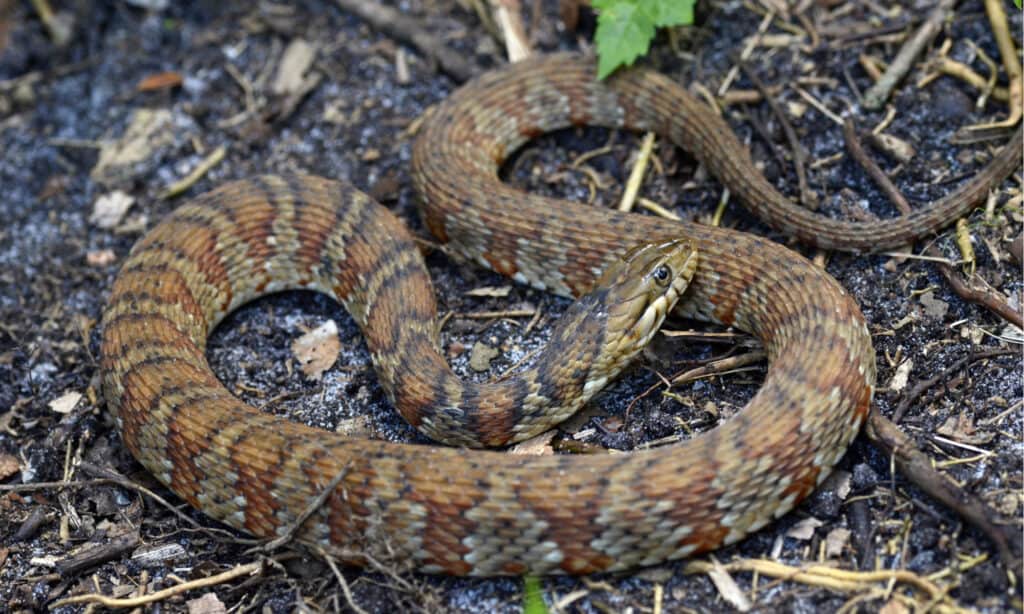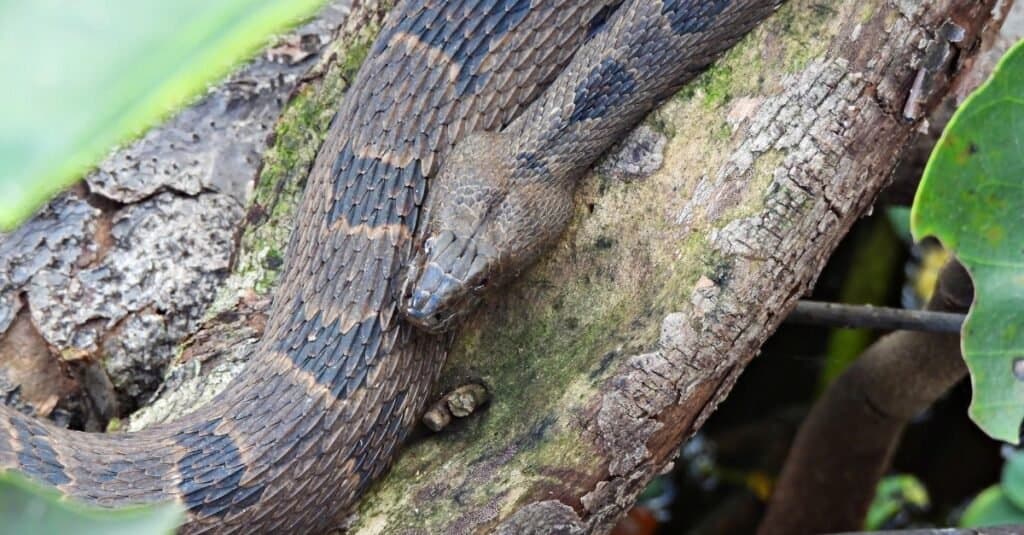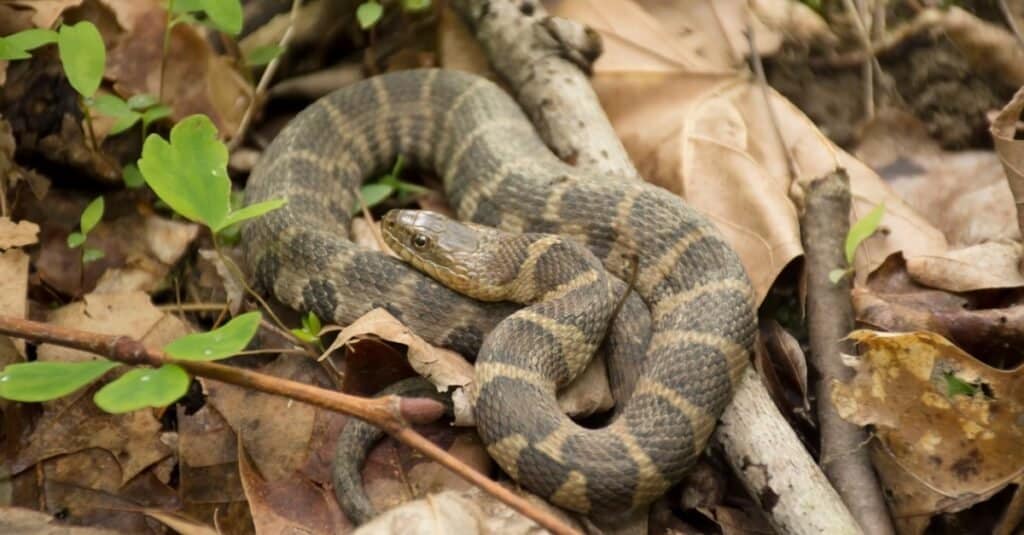4 Water Snakes In North Carolina
#mobileSnakeQuizControls { overflow: hidden; text-overflow: ellipsis; white-space: nowrap; }
@media (min-width: 481px) {
.mobile-top-content {
display: none;
}
}
#mobileTopContentCTACarouselControls { overflow: hidden; text-overflow: ellipsis; white-space: nowrap; }
.mobile-top-content .more { color: #fff; }
.mobile-top-content a { color: #fff; text-decoration: underline; }
.mobile-top-content a:hover { color: #fff; text-decoration: underline; }
@media (max-width: 480px) {
.mobile-top-content {
background-color: #06a10b;
color: #fff;
text-align: center;
/*height: 60px;
padding-top:5px;*/
font-size:80%;
/* display: block; */
margin: 0px -30px;
}
}
North Carolina is known for its beautiful landscape with rugged mountains, barrier islands, rolling fields, and a vast network of rivers and streams. Therefore, it’s no surprise that there are also some incredible flora and fauna in the state. Amongst these are snakes, which are known for being able to live in virtually every habitat. However, some of the most unique snakes are water snakes. Water snakes are snakes from the genus Nerodia which are all non-venomous. There are about nine species of water snakes across North America, and four of them are native to North Carolina. Although there are several other species that are found in water – such as cottonmouths, swamp snakes, crayfish snakes, and mud snakes – there are only four that are true water snakes. So join us as we learn about the water snakes in North Carolina!
Banded Water Snake

Patrick K. Campbell/Shutterstock.com
Despite also being known as southern water snakes, banded water snakes are named for their crossband markings. These snakes (Nerodia fasciata) are usually brown, gray, or greenish-gray with darker bands and cream or yellow colored belly. However, these crossband markings sometimes disappear as the snake becomes a darker color with age. Banded water snakes have heavy bodies which are 24 to 42 inches long, with females typically larger than males both in length and weight. They also have flat heads and strongly keeled scales down their backs.
button.pulse {
transform: scale(1); animation: pulse 2s infinite;
box-shadow: 0 0 0 0 rgba(11, 247, 25, 1);
}
@keyframes pulse {
0% { transform: scale(0.90); box-shadow: 0 0 0 0 rgba(11, 247, 25, 0.5); }
60% { transform: scale(1); box-shadow: 0 0 0 15px rgba(11, 247, 25, 0); }
100% { transform: scale(0.90); box-shadow: 0 0 0 0 rgba(11, 247, 25, 0); }
}
Banded water snakes live in any body of shallow freshwater, such as ponds, streams, lakes, and swamps. They are most active at night but typically spend their days basking in the sun on logs near the water’s edge. However, they rarely stray far from the water or the vegetation surrounding the shore. Banded water snakes are viviparous, which means that they give birth to live young rather than laying eggs. Juveniles are between 8 and 9 inches long when they are born, which is typically in July or August. Banded water snakes primarily eat fish and frogs, which they swallow alive. However, juveniles initially eat only fish because frogs are typically too large for them to swallow until they are older.
Brown Water Snake

iStock.com/passion4nature
Another water snake in North Carolina is the brown water snake (Nerodia taxispilota). Brown water snakes are one of the most common water snakes in North America. They are 30 to 60 inches long and are brown with around 25 darker blotches down their back and smaller blotches down their sides. These snakes have thick, heavy bodies, but their neck is noticeably narrower than their head. They also have yellow bellies which have brown or black markings. Brown water snakes live in rivers, streams, and swamps – often in low coastal regions. They are also excellent climbers and can be found as high as 20 feet up in trees. Mating sometimes takes place on tree branches. These snakes are ovoviviparous, which means that the embryos develop in eggs inside the female’s body until they are ready to hatch, after which they are born alive.
Brown water snakes are often called false moccasins. This is due to their close resemblance and similar habitat to cottonmouths (which are known as water moccasins). As a result of this, many brown water snakes are killed every year by people who mistakenly identify them as cottonmouths. However, there are a few differences between the two. Brown water snakes have round pupils, while cottonmouths have elliptical pupils. Additionally, brown water snakes’ eyes can’t be seen from above, while cottonmouths’ can. Despite their resemblance to cottonmouths, brown water snakes are not venomous. Although they can bite if cornered, they prefer to flee in the face of danger. Also, brown water snakes are not constrictors, and their prey (mainly fish) is usually grabbed and swallowed alive.
Northern Water Snake

iStock.com/IcemanJ
Also known as common water snakes, northern water snakes are brownish-black with crossband markings on their neck and blotches down their body. These snakes (Nerodia sipedon) are large snakes that can reach lengths of up to 54 inches. There are currently four subspecies – Lake Erie water snake, midland water snake, Carolina water snake, and the northern water snake.
Northern water snakes live in permanent water sources such as ponds, streams, rivers, lakes, and swamps. They are active both during the day and during the night and can often be seen basking on logs and rocks near the shore. However, they react immediately to any potential threats and quickly dive back into the water. Although they are quick to flee, they will readily bite if they are cornered, and bites from larger snakes can be particularly painful. Additionally, their saliva contains an anticoagulant which means that bites bleed more than usual. Northern water snakes hunt in and around the water, where they prey on fish, frogs, salamanders, birds, and small mammals. They have a lot of predators, with us humans being one of the main ones when we mistake them for venomous cottonmouths. Other predators include turtles, raccoons, and foxes.
Plain-Bellied Water Snake

/Shutterstock.com
The final water snake in North Carolina is the plain-bellied water snake (Nerodia erythrogaster). Plain-bellied water snakes are 24 to 40 inches long and have heavy bodies. They are usually brown, gray, green, or black on their dorsal side but have yellow or reddish-orange bellies. There are six recognized subspecies, but plain-bellied water snakes are now generally considered to be just one widespread and varied species. These snakes always live near permanent water sources, such as rivers, swamps, streams, ponds, and lakes. However, they are absent from the western region of North Carolina. Plain-bellied water snakes spend more time out of the water than any other water snake and typically flee across the land when threatened rather than into the water. They are active during both the night and day in the summer and hibernate during the winter.
Like the other water snakes, plain-bellied water snakes are ovoviviparous. They give birth from August to September, and although broods usually consist of around eighteen juveniles, a record of 55 was observed in North Carolina. These snakes are not constrictors and usually grab their prey and swallow it alive. They also sometimes lie in wait in shallow water to ambush their prey. Their diet mainly consists of fish, frogs, and salamanders. Plain-bellied water snakes also have a lot of predators, including kingsnakes, cottonmouths, hawks, and largemouth bass.
Discover the “Monster” Snake 5X Bigger than an Anaconda
Every day A-Z Animals sends out some of the most incredible facts in the world from our free newsletter. Want to discover the 10 most beautiful snakes in the world, a “snake island” where you’re never more than 3 feet from danger, or a “monster” snake 5X larger than an anaconda? Then sign up right now and you’ll start receiving our daily newsletter absolutely free.
More from A-Z Animals
.more-snake-card-image { max-height:140px !important; }
#mobileSnakeQuizControls { overflow: hidden; text-overflow: ellipsis; white-space: nowrap; }
@media (min-width: 481px) {
.mobile-top-content {
display: none;
}
}
#mobileTopContentCTACarouselControls { overflow: hidden; text-overflow: ellipsis; white-space: nowrap; }
.mobile-top-content .more { color: #fff; }
.mobile-top-content a { color: #fff; text-decoration: underline; }
.mobile-top-content a:hover { color: #fff; text-decoration: underline; }
@media (max-width: 480px) {
.mobile-top-content {
background-color: #06a10b;
color: #fff;
text-align: center;
/*height: 60px;
padding-top:5px;*/
font-size:80%;
/* display: block; */
margin: 0px -30px;
}
}
North Carolina is known for its beautiful landscape with rugged mountains, barrier islands, rolling fields, and a vast network of rivers and streams. Therefore, it’s no surprise that there are also some incredible flora and fauna in the state. Amongst these are snakes, which are known for being able to live in virtually every habitat. However, some of the most unique snakes are water snakes. Water snakes are snakes from the genus Nerodia which are all non-venomous. There are about nine species of water snakes across North America, and four of them are native to North Carolina. Although there are several other species that are found in water – such as cottonmouths, swamp snakes, crayfish snakes, and mud snakes – there are only four that are true water snakes. So join us as we learn about the water snakes in North Carolina!
Banded Water Snake

Patrick K. Campbell/Shutterstock.com
Despite also being known as southern water snakes, banded water snakes are named for their crossband markings. These snakes (Nerodia fasciata) are usually brown, gray, or greenish-gray with darker bands and cream or yellow colored belly. However, these crossband markings sometimes disappear as the snake becomes a darker color with age. Banded water snakes have heavy bodies which are 24 to 42 inches long, with females typically larger than males both in length and weight. They also have flat heads and strongly keeled scales down their backs.
button.pulse {
transform: scale(1); animation: pulse 2s infinite;
box-shadow: 0 0 0 0 rgba(11, 247, 25, 1);
}
@keyframes pulse {
0% { transform: scale(0.90); box-shadow: 0 0 0 0 rgba(11, 247, 25, 0.5); }
60% { transform: scale(1); box-shadow: 0 0 0 15px rgba(11, 247, 25, 0); }
100% { transform: scale(0.90); box-shadow: 0 0 0 0 rgba(11, 247, 25, 0); }
}
Banded water snakes live in any body of shallow freshwater, such as ponds, streams, lakes, and swamps. They are most active at night but typically spend their days basking in the sun on logs near the water’s edge. However, they rarely stray far from the water or the vegetation surrounding the shore. Banded water snakes are viviparous, which means that they give birth to live young rather than laying eggs. Juveniles are between 8 and 9 inches long when they are born, which is typically in July or August. Banded water snakes primarily eat fish and frogs, which they swallow alive. However, juveniles initially eat only fish because frogs are typically too large for them to swallow until they are older.
Brown Water Snake

iStock.com/passion4nature
Another water snake in North Carolina is the brown water snake (Nerodia taxispilota). Brown water snakes are one of the most common water snakes in North America. They are 30 to 60 inches long and are brown with around 25 darker blotches down their back and smaller blotches down their sides. These snakes have thick, heavy bodies, but their neck is noticeably narrower than their head. They also have yellow bellies which have brown or black markings. Brown water snakes live in rivers, streams, and swamps – often in low coastal regions. They are also excellent climbers and can be found as high as 20 feet up in trees. Mating sometimes takes place on tree branches. These snakes are ovoviviparous, which means that the embryos develop in eggs inside the female’s body until they are ready to hatch, after which they are born alive.
Brown water snakes are often called false moccasins. This is due to their close resemblance and similar habitat to cottonmouths (which are known as water moccasins). As a result of this, many brown water snakes are killed every year by people who mistakenly identify them as cottonmouths. However, there are a few differences between the two. Brown water snakes have round pupils, while cottonmouths have elliptical pupils. Additionally, brown water snakes’ eyes can’t be seen from above, while cottonmouths’ can. Despite their resemblance to cottonmouths, brown water snakes are not venomous. Although they can bite if cornered, they prefer to flee in the face of danger. Also, brown water snakes are not constrictors, and their prey (mainly fish) is usually grabbed and swallowed alive.
Northern Water Snake

iStock.com/IcemanJ
Also known as common water snakes, northern water snakes are brownish-black with crossband markings on their neck and blotches down their body. These snakes (Nerodia sipedon) are large snakes that can reach lengths of up to 54 inches. There are currently four subspecies – Lake Erie water snake, midland water snake, Carolina water snake, and the northern water snake.
Northern water snakes live in permanent water sources such as ponds, streams, rivers, lakes, and swamps. They are active both during the day and during the night and can often be seen basking on logs and rocks near the shore. However, they react immediately to any potential threats and quickly dive back into the water. Although they are quick to flee, they will readily bite if they are cornered, and bites from larger snakes can be particularly painful. Additionally, their saliva contains an anticoagulant which means that bites bleed more than usual. Northern water snakes hunt in and around the water, where they prey on fish, frogs, salamanders, birds, and small mammals. They have a lot of predators, with us humans being one of the main ones when we mistake them for venomous cottonmouths. Other predators include turtles, raccoons, and foxes.
Plain-Bellied Water Snake

/Shutterstock.com
The final water snake in North Carolina is the plain-bellied water snake (Nerodia erythrogaster). Plain-bellied water snakes are 24 to 40 inches long and have heavy bodies. They are usually brown, gray, green, or black on their dorsal side but have yellow or reddish-orange bellies. There are six recognized subspecies, but plain-bellied water snakes are now generally considered to be just one widespread and varied species. These snakes always live near permanent water sources, such as rivers, swamps, streams, ponds, and lakes. However, they are absent from the western region of North Carolina. Plain-bellied water snakes spend more time out of the water than any other water snake and typically flee across the land when threatened rather than into the water. They are active during both the night and day in the summer and hibernate during the winter.
Like the other water snakes, plain-bellied water snakes are ovoviviparous. They give birth from August to September, and although broods usually consist of around eighteen juveniles, a record of 55 was observed in North Carolina. These snakes are not constrictors and usually grab their prey and swallow it alive. They also sometimes lie in wait in shallow water to ambush their prey. Their diet mainly consists of fish, frogs, and salamanders. Plain-bellied water snakes also have a lot of predators, including kingsnakes, cottonmouths, hawks, and largemouth bass.
Discover the “Monster” Snake 5X Bigger than an Anaconda
Every day A-Z Animals sends out some of the most incredible facts in the world from our free newsletter. Want to discover the 10 most beautiful snakes in the world, a “snake island” where you’re never more than 3 feet from danger, or a “monster” snake 5X larger than an anaconda? Then sign up right now and you’ll start receiving our daily newsletter absolutely free.







